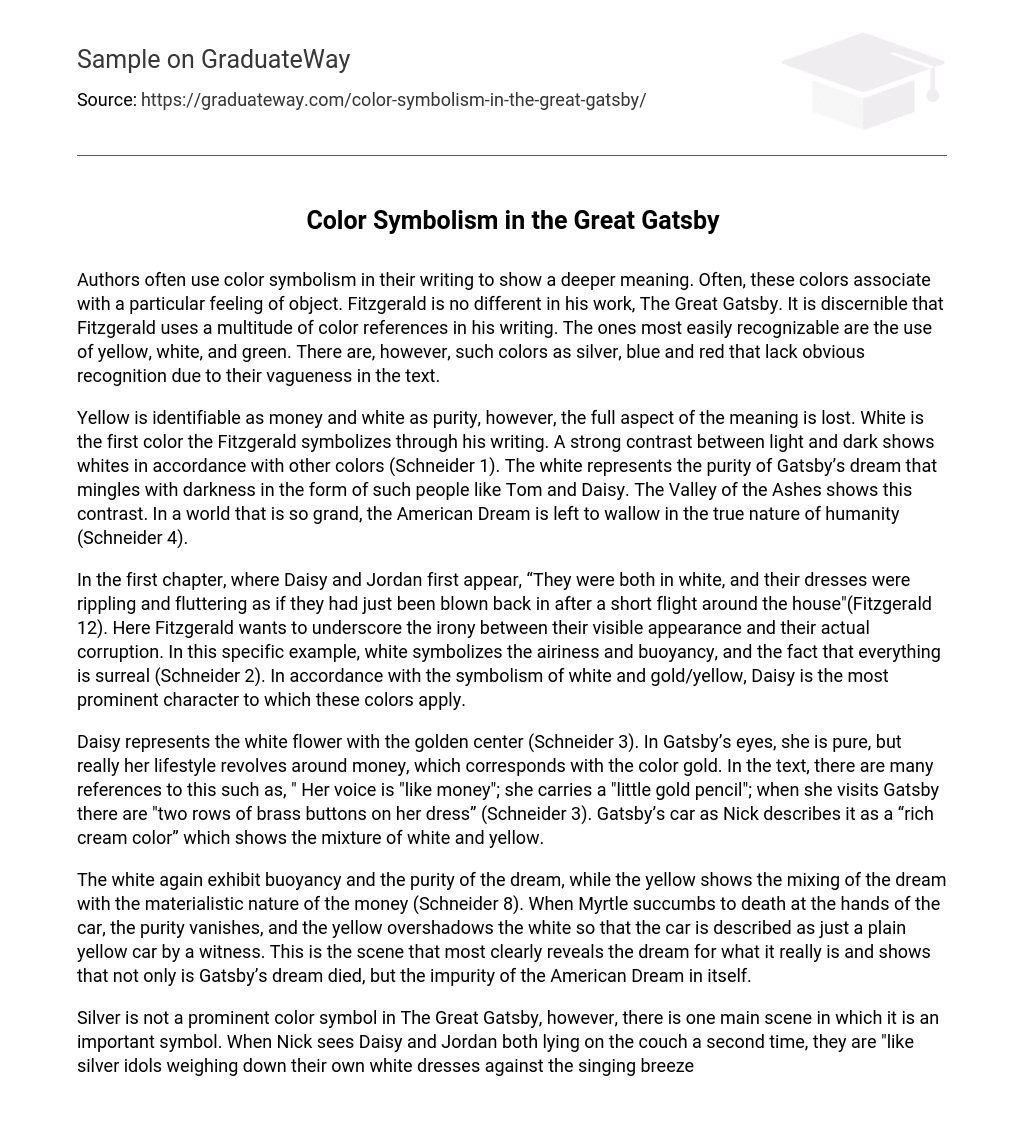Color symbolism is often used by authors to convey deeper meanings in their writing, and this holds true for Fitzgerald’s novel, The Great Gatsby. Fitzgerald clearly incorporates a range of colors throughout his work, with yellow, white, and green being particularly prominent. However, there are additional colors like silver, blue, and red that may not be as readily apparent due to their more ambiguous portrayal in the text.
While the recognition of yellow symbolizing money and white representing purity is apparent, its complete significance remains not fully comprehended. Fitzgerald initially uses the color white as a symbolic element in his writing. The contrast between light and dark serves to emphasize how other colors are associated with white (Schneider 1). Within his narrative, white signifies the pure nature of Gatsby’s dream, which becomes entwined with darkness due to individuals like Tom and Daisy. This stark juxtaposition can be observed in the Valley of the Ashes, where the opulence of society overshadows the true essence of humanity, thus overshadowing the American Dream (Schneider 4).
The opening chapter introduces Daisy and Jordan, dressed in white garments that have a rippling and fluttering effect, as if they had just returned from a brief flight around the house (Fitzgerald 12). Fitzgerald aims to highlight the contradiction between their outward appearance and their underlying corruption. This particular example of white attire symbolizes lightness, buoyancy, and a sense of unreality (Schneider 2). Consequently, white and gold/yellow symbolism are primarily associated with Daisy, making her the central character embodying these colors.
Daisy is symbolic of the white flower with a golden center (Schneider 3). Gatsby views her as pure, yet her lifestyle revolves around wealth, which symbolically aligns with the color gold. Numerous references in the text support this notion, such as her voice being described as “like money”, her possession of a “little gold pencil”, and the presence of “two rows of brass buttons” on her dress when she visits Gatsby (Schneider 3). Nick describes Gatsby’s car as a “rich cream color”, showcasing the combination of white and yellow.
In accordance with Schneider (8), the white signifies buoyancy and purity of the dream, while the yellow symbolizes the combination of the dream with materialism associated with money. After Myrtle’s demise caused by the car, purity diminishes and the prominence of yellow outweighs white. A witness describes the car as a mere plain yellow car, symbolizing the stark reality of the dream. This particular scene exposes the true nature of Gatsby’s faded dream and further exemplifies the impurity of the American Dream itself.
Silver is not a prominent color symbol in The Great Gatsby, but it is significant in one main scene. In this scene, when Nick sees Daisy and Jordan lying on the couch again, they appear “like silver idols weighing down their own white dresses against the singing breeze of the fans” (Fitzgerald 122). Silver symbolizes both the dream and reality in Gatsby’s life, representing the romantic hope and promise that govern his life (Schneider 3).
One instance illustrating this romantic aspect occurs in the opening scene where Nick observes Gatsby looking up at the stars with a longing that carries a touch of romance. Additionally, the color silver is symbolic of wealth, depicting the tainted nature of the dream. Another color that requires clarification is green. While yellow is a prominent color in the novel, the use of blue represents the promise and illusion mistaken for reality by Gatsby (Schneider 5).
In Fitzgerald’s novel, the green light symbolizes the desire of Daisy and Gatsby to be reunited. This green light combines the blue of Gatsby’s hopeful dream with the impurity of money and its role in Daisy’s life. Gatsby is blinded by his idealized perception of truth, leading to his downfall. His pursuit of a tainted grail ultimately results in his death and the corruption of the American Dream. Fitzgerald skillfully employs color, particularly yellow, silver, and green, to convey the true corruption at the heart of The Great Gatsby. These colors offer subtle hints about the true nature of events throughout the novel.
Works Cited
- Fitzgerald, F. Scott. The Great Gatsby. New York: Charles Scribner’s Sons, 1925.
- Schneider, Daniel J. Color- Symbolism in The Great Gatsby. n. d. Salem Press. 4 March 2012.
- http://search.ebscohost.com/login. aspx?direct=true&db=lfh&AN=48218028&site=lrc-live>.





